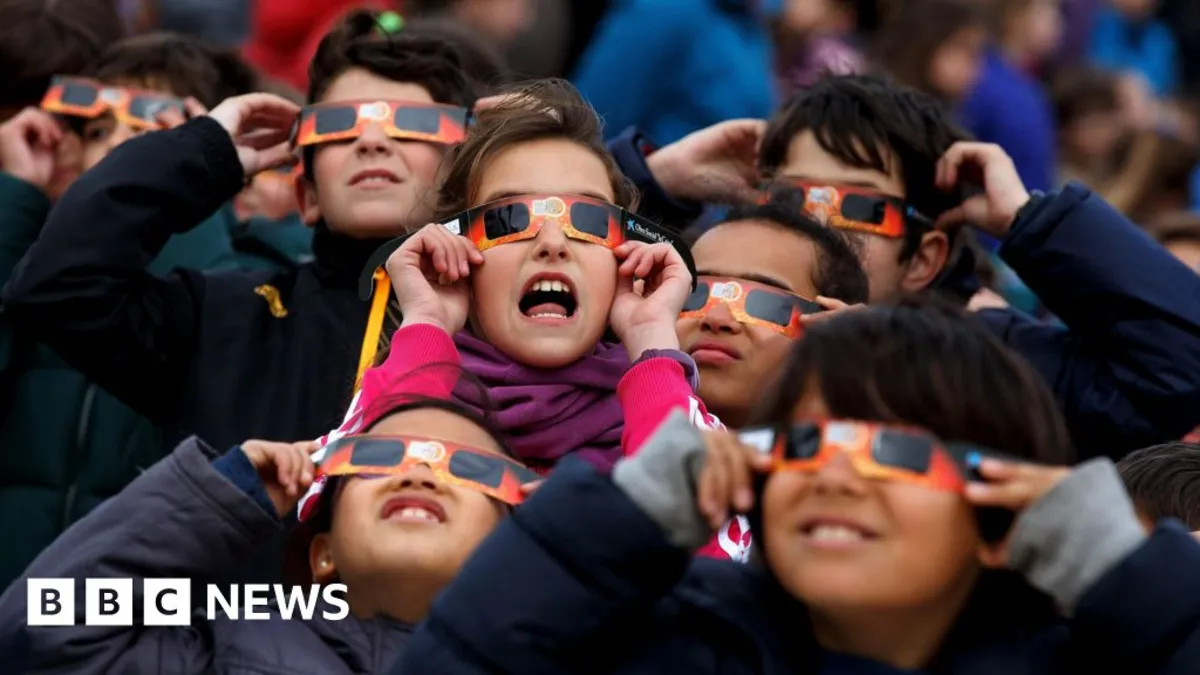
Get your protective eclipse glasses ready! Weather permitting, you’ll have the opportunity to witness the Moon take a 'bite' out of the Sun this Saturday morning. The partial solar eclipse will be visible across the UK, offering skywatchers a chance to see the Moon cover approximately 30% to 50% of the Sun at its peak. The best prospects for clear skies are anticipated in regions like south-east England, East Anglia, and the Midlands.
While the partial solar eclipse won’t be total anywhere in the world, parts of northeastern Canada will experience up to 92% of the Sun obscured. It's crucial to remember that you must never look at the Sun directly, as this can cause severe damage to your eyes. Therefore, using special eclipse glasses is essential if you plan to take a peek at this celestial event.
The partial solar eclipse will be visible across Europe, Northwestern Africa, Greenland, Iceland, and parts of the northeastern US and eastern Canada, with varying levels of visibility. In the UK, the eclipse will commence at 10:07 AM and conclude around midday. Different areas in the UK will witness varying degrees of coverage; for example, the Outer Hebrides can expect up to 47% of the Sun obscured, while Dover in southeast England will see around 28%.
For precise timings based on your location, it's recommended to check Time and Date. Anna Gammon-Ross, Senior Planetarium Astronomer at Royal Museums Greenwich, states, “This is an excellent chance to go out, look – safely – and to experience the movement of the solar system for yourself. It’s such a wonderful way to connect to everything happening and see it all in action.”
A solar eclipse occurs when the Moon moves between the Sun and Earth, blocking some or all of the Sun's light. There are different types of solar eclipses, categorized by the extent of the Sun’s obscuration:
Partial Solar Eclipse: The Moon partially covers the Sun, leaving a crescent-shaped section visible.Annular Solar Eclipse: The Moon is directly in front of the Sun but appears smaller, creating a thin, bright ring of sunlight around its edges.Total Solar Eclipse: The Moon completely covers the Sun, revealing a glowing outer atmosphere known as the corona.Skywatchers in the UK can look forward to another partial solar eclipse on August 12, 2026. During this event, regions like the Arctic, eastern Greenland, Iceland, and northern Spain will experience a rarer total eclipse. However, the UK will not witness another full solar eclipse until September 23, 2090, according to the Royal Observatory in Greenwich. The last total solar eclipse visible in the UK occurred in 1999, where Cornwall was the only location to experience totality, attracting thousands of visitors to the area.
Taking the proper precautions is vital for safely viewing a solar eclipse. Even during a partial eclipse, it is unsafe to look directly at the Sun without protection, as this can lead to eye damage or even blindness. Solar eclipse glasses are specifically designed to filter out harmful UV rays and reduce the Sun's brightness, making it safe to view the eclipse. Regular sunglasses are not sufficient, as they do not block enough light to protect your eyes from the Sun's intense rays.
Miss Gammon-Ross emphasizes, “If you blocked as much sunlight with your sunglasses as eclipse glasses do, you wouldn’t be able to see where you were going!” If you lack access to eclipse glasses, you can create a simple pinhole camera using two sheets of cardboard or even utilize a colander to project the Sun's image onto the ground. Local astronomical societies may also organize eclipse events, featuring telescopes equipped with solar filters. Additionally, the Royal Observatory in Greenwich will host a live stream of the March 2025 solar eclipse, allowing viewers across the UK to experience the event online in real time.
As for the weather on Saturday morning, conditions may vary across the UK, impacting visibility of the eclipse. The best chances for clear skies are anticipated in south-east England, East Anglia, and the Midlands. However, some high cloud may appear but is not expected to obstruct the view significantly. In Wales and northern and western regions of England, the chances of clear skies are lower, with increasing cloud cover likely throughout the morning. Sky gazers in Scotland and Northern Ireland may face challenging conditions, including thick clouds and rain, particularly in the northern and western areas.
Stay tuned for more updates, and don’t miss out on this incredible opportunity to witness a partial solar eclipse safely!